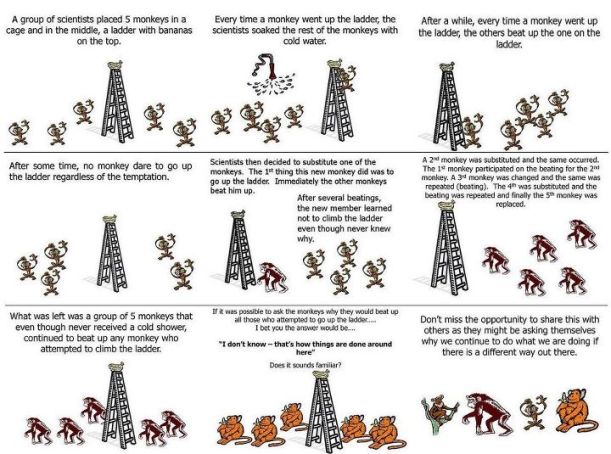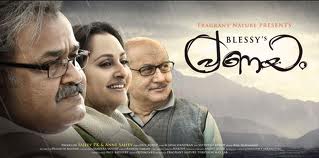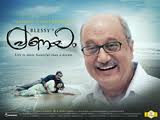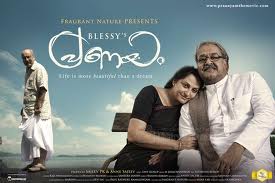Pulled this one out of the drafts (lying there for the past six months or so).
I’m too close to this subject as well (as all those other rambles here :D) so I wonder if I shall do justice at all. Let’s just leave it at that. (These are the murmurings to self, so please take as disclaimer or simply ignore 🙂 ). That’s already two smileys I should not be using at all, given the weight of the gravity of the topic.
Shifting paradigms of education, especially this day, especially the innovations, the trends, the tacky problems they generate, and our readiness or lack of it, in confronting it. That is what I hope to given direction to, here. As a parent, a practitioner, professionally, as a keen participant in the unfolding scenario. My take.
Recently, on Facebook, I had come across this picture, on how paradigms are created. It has its own stark message, glaring out from the humour in the picture. You’ll understand when you see this. (Picture courtesy one Jai Murugan on FB who had uploaded this picture. All credit to whomsoever created it).
That is the first statement that is given when one is confronted with a change of pattern in operating stuff. Be it teaching, be it a new filing system. “Why change?” “This is the way things are done here!” No argument for change has ever been received with unstinted support even though one realizes that it is beneficial. Because that is the way things have always been done.
It’s not just about the comfort zone one has to move out from. It’s the thought of unlearning, and learning again; the ‘why bother…’; the “Oh it’s not better definitely, so why try?’; and innumerable arguments.
I’d like to specifically talk of the shift in the Education Methodology, of actually translating it into workable solutions at ground level and also the level of acceptability it has received, from all the “stakeholders” (new terminology to boot!) here – the parent, the teacher, the institution, the learner. Specifically, I’m talking of Mr Kapil Sibal’s baby, the CCE (Continuous and Comprehensive Education), in the CBSE stream (part of the MHRD initiative).
The bare bones of it all, first. CCE was first introduced in the Primary School level way back in 2004 (strictly to be adhered then). As its name suggests, it had to be continuous, and comprehensive assessment of the learner- both academic and co curricular. Now there were no checks on whether it was being done, and schools adopted it to different degrees, in different manners. Ideally there should have been no examinations or formal testing (as in Unit Tests), and assessment had to cover a range of the child’s potential and abilities. Tough. Especially for the teacher. Now you know why it never came through successfully.
Though the history of its implementation and the work behind it, attributed to recommendations by different committees and groups, and especially the NCF, National Curriculum Framework, at different points in time, is extended backwards to a good many years, it was the NCF 2005 that finally brought in a measure of seriousness. When CBSE took note that the implementation at Primary Level left much to be desired, it went into action, and went for the Jugular (great! I’ve actually got a natural context to use this word, unlike here :D). They introduced CCE in Class 9, during October 2009. Imagine the chaos! Suddenly CBSE was dictating terms as to how assessment was to be done, in Class 9 which would impact performance, standards, outcomes, in terms of results, and bring about a sea change, in perception, planning and practice. Many of the fraternity are still drowning in that sea, almost 2 years hence.
In its present form CCE has been implemented fully in CBSE schools right from Class 1 to Class 10. Quite successfully, even if under protest. There is a paradigm shift here, one that, I feel, has been good, especially for the learner group. That, finally, is what matters. So what does it entail? Please bear with me, while I climb on my hobby horse and give you the structuring of the concept.
Assessment is the key word. And that comes from both teacher and student. Peer group and self assessment are also very very important. The whole year is split into two terms. Each term into two blocks of Formative Assessment -FA-(internal assessment, as many are fond of calling it – it actually is the assessment that is there for, and of learning, in small bits), and Summative Assessment, the end of term assessment by way of a pen and paper examination. In FA, there should not be more than 1 pen and paper class test. A variety of other tools and techniques have been provided in the Teachers’ Manual – some of which include presentations, charts, seminars, projects, speech, recitation, interviews, creating MCQs (Multiple Choice Questions) on lessons done, offering opinions, debates, group discussions… The SA includes all the content of that term alone. Only grades are given and no marks ar e entered in the Report Card (which is now an exhaustive document of the child’s personality)
A very important part of the change was the emphasis given to Co-Scholastic Areas of Life Skills, Attitudes and Values, Activities and Skills, Physical and Health parameters. These were to be graded, and a suitable descriptive indicator had to be written down. That is a sort of remark on that area of the child’s personality. CBSE went one step further and upgraded the Scholastic Grades of those who had very good Co-Scholastic Grades, up one level. Such is the importance given to that.
So why has it been met with so much resistance? Some of you who have young children still in school, esp. a CBSE school might want to protest and request that the entire system be reverted back to when examinations ruled. One Board Exam at the end of 10th to decide. That is one of the main reasons that CCE was implemented. To guard against the unreal outcome of such an exercise where the child who remembers, understands, can expostulate and write, emerges the undisputed winner. In the new system, you make it happen for most of the children. It’s the argument about standardised testing, and about different individuals being just that … different… in their abilities, so should that not also be taken into account? Multiple Intelligences (Howard Gardner – unfortunately in the time I did B.Ed., this was not disucussed- now this is a key point in Pedagogy, rightfully so.) – such as Logical, Linguistic, Aural, Visual, Bodily-Kinesthetic, Spatial, Intrapersonal… to name a few, matter, this day and age, because each of us is able to absorb information in different ways. What once was accepted as the rigid way of study, no longer holds true. Take a look at this:
Pic from FB.
“Everybody is a genius. But if you judge a fish by its ability to climb a tree, it will live its whole life believing that it is stupid.” Albert Einstein
The above is a link to a part of a textbook in Class X. This is a new and improved version of one of the text books in Class X, where the cartoon above clearly illustrates the theme for the Lesson called “Inclusive Education”, in the second Unit- Education. The breadth of the theme is beautifully enunciated, and the entire book, though too exhaustive for an average learner, is an eyeopener for the learner group, as well as the teacher herself/himself. Do read that lovely little lesson, on Page 56, Unit 2, Lesson C. Inclusive Education.
The points raised by many of the parents I know who have a difficulty accepting CCE runs thus:
- Children will forget how to write exams, and their life, after school is going to be dictated by it
- FA, esp. the assessment in class, how can we be sure the teacher is objective?
- The subjectivity of the teacher in awarding grades in Co-Scholastic areas, esp. if the child is always flattering the teacher, or irritating him/her no end!
- Projects; kids dont do it, others do!
- Assignments, which they copy from each other
- Kids dont have a social life now; each day there is assessment, so the brighter ones refuse to go out, meet or visit with family friends, attend functions!
- All the teachers give tests, assignments at the same time. Sigh.
- This is just like DPEP (District Primary Education Programme), the initiative by the Kerala Government, among the first to introduce a form of CCE in its schools, very systematically. Unfortunately DPEP has been read as Dridra Pillerr Enganengilum Padichotte– meaning Let the Poor Children somehow study (Poor as in poor.)
- How do you assess co-scholastic areas, especially when you have a class of 50 or thereabouts? (Very valid point there!)
- Always activity, always activity… give them a break!
- In English, where can they get the speeches from?
- They take everything from the internet, so what are they being original and creative about?
- I dont have a computer, and I have to spend so much on taking my child to the Internet Cafes, and for the printouts of pictures, weblinks.
- Yada yada yada…. 🙂 (I do not mean any disrespect here, but most of the other points are the ones above, reworded- sometimes people find nothing positive about change and that depresses me!)
I don’t want to counter each point there, but I would like to put forth my rationale, on why I think it works for me, and the way I see it.
- While earlier only a child’s ability to perform in a test was taken as the measure of that child, now it is way different! He/she may have other skills even in academic areas which are given due consideration and weightage!
- Yes there is the problem of class strength, but if we are going to keep postponing change till we achieve the ideal number in class status, we might never start. Sometimes we need to take that leap of faith.
- Projects? Well, from the ones that used to be given as home assignment, now they do it in groups, in class, during class time. So who does it? Individual reports on it are taken from members to assess their learning, and their contributions 🙂
- Teachers are still learning along with the students, and here I must add that CBSE has yet to take greater initiative in teacher inservice courses to help us better. (The Kerala Education system has done some wonderful work on this front)
- Teacher objectivity will always be in question, no matter how respected that teacher is. But in the case of Co-scholastic grades, awarded, a team of teachers decides, and it is always in favour of the child concerned. We do that. Really.
- Yes, it is exhausting for the teacher, just as much as you imagine it is for the child. Though for the child I do think a bit of organizing by the family and the teachers in school, can ease the strain. As a teacher, I do understand so much more now, the value of planning, and the lack of our efforts in that direction. Sorry truth, that is.
- The children and their parents need to know how to use the internet, and if they do get information from there, well, good job! It is how they use this, even in their speeches, without taking it in verbatim that we are going to assess. And it tells when they simply spout without know what! I love flushing out those who do that :D! Poor kids!
- Yes, there is much to be improved, and it is still evolving, but I think a world of good has been done to more than majority with the easing out of marks, and entry of Grades; how they feel less threatened by the report card, which has much by way of detail of the persona of the child as against only the academic achievement that once used to rule the roost.
- Slowly, but surely, a lot of parents are working towards accepting it, or at least seeking to be informed about it so that they may better help the focal point of all this, the child.
I do hope the CBSE will work with greater interest towards easing the burden upon the teacher now, who has to plan and execute most of the learning and assessment, not to mention the Report Card work by issuing more guidelines, giving in service courses, right through the country, instead of just the North and the Central areas. Much work needs to be done by them to bring the effort to a better standard both in performance and in achievement of the said objectives.
- Maintain schedules for study uniformly instead of allowing each school to set their own timeframe. Sometimes a uniformity, at least in the time frame (instead of just saying April to September, I Term, October to March, II Term), goes a long way in ensuring greater stability
- Give a uniform schedule of the SA to be conducted (now each school can decide their own timetable and their own question paper from the Question Bank sent by CBSE – which incidentally is not very secure, it being sent in CDs to the school, where anyone who has access to it can take and leak papers– or create their own)
- For the SA, again, give the timetable to be followed by each school. Exceptions may be made to rural schools or those in far flung areas that need special consideration – but make sure you identify them
- There is an exhaustive amount of suggested activity/ exercises in some texts, in Class 9 and 10. Most schools have a policy that all.. ALL.. the exercises MUST be done, which makes it difficult, esp. for the learner. When text books are designed, it is always better to ensure the right amount, for the average learner, and maybe a couple of things more for the brighter ones, isn’t it?
- Books, on time please! The CBSE publications’ books Interact in English Series this year was delayed by more than 4 months and therefore photostat copies had to be taken, then books bought when finally it was available… It was utterly beyond excuse!
- But, most importantly, the schedules.
Here is how a sample report card looks, in the new CCE pattern. I’d have loved my kids to have one like this. At the end of Class 10, a printed report card, summarizing all these details from Class 9 and 10 are given. A thoroughly detailed picture of the child!
(Image, courtesy, Google Images)
I’ve saved the best for last. Three videos on creativity, education systems and the need to change our thinking.
Sir Ken Robinson, Educator, Creativity Expert, had given a series of talks on Tedtalks on the Educational System and Creativity, and the need to bring on learning revolution. I’ve shared these on Facebook, having first heard of them from Jennifer Robertson, a very creative and accomplished poet. Each of these links below is worth watching, when you have time. The first one below, a MUST. It is an animation of a speech he gave on the same topic – a 20 minute speech condensed beautifully into half that time, and aptly.
1. Changing Educational Paradigms (Animated by RSA)
http://www.youtube.com/watch?v=zDZFcDGpL4U
Animation of Sir Ken Robinson’s talk on the same topic
2. Bring on the learning revolution
http://www.youtube.com/watch?v=r9LelXa3U_I
3. Do schools kill creativity
31 October, 2011
Link worth exploring: CBSE’s CCE home page, which has all the information about it, and esp. Circulars, the Manuals, and books.
Sigh. Word count 2500+.
And thus I dismount from my hobby horse, and quit shouting atop my soapbox! Very liberating, having no one to breathe down your neck and utter dire threats about wrecking your spine, sitting at the computer, and dishing out those 2600+ words, almost in one session! Very liberating. But I leave now, satisfied. Another rant freed. 😀
P.S. There is much left to say on finer points of the whole new way. Would be glad to add, if needed, by way of replies to comments. Thank you for your patience, if you read up till here!







